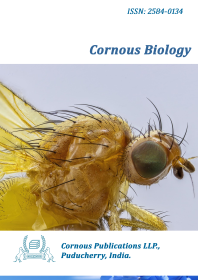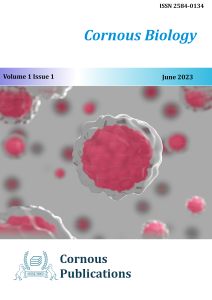

Due to their slight negative effects on the environment, environmentally friendly nematode control techniques have been suggested. In order to determine the effectiveness of moringa leaf extracts and vermicompost alone and together against the root-knot nematodes, Meloidogyne javanica in pepper, the experiment was carried out in a greenhouse at the Ambo Agricultural Research Center., according to the results, 500 gm vermicompost and 80 gm moringa provided the greatest reduction in gall number per root (8), egg mass per 10 gm root (2), population density per 100 gm soil (108), and nematode reproduction factor (0.05). Vermicompost 500gm and moringa 60gm were also effective when combined. Additionally, organic amendments have a favorable effect on plant biomass. The findings obviously show that vermicomposting with plant products is more advantageous in organic farming. It is useful to control the damaging nematodes as well as for the improvement of soil nutrients.
moringa, organic amendments, root-knot nematode, strategies, vermicompost
Adegbite, A.A. (2003). Comparative effects of carbofuran and water extract of Chromolaena odorata on growth, yield and food component of root knot nematodes infested soybean (Glycine max L. Merril) Ph.D. Diss., University of Ibadan, Ibadan, Nigeria. J. Veg. Sci., 12, 5–12.
Agrios, G.N. (2005). Introduction to Plant Pathology (5th Edition). Elsevier Academic Press Publication.
Ahmad, F., Rather, M.A., & Siddiqui, M.A. (2007b). Impact of organic soil amendments and nematicides on Meloidogyne incognita infecting tomato. Indian J. Nematol., 37, 55-57.
Belay, F., Alemu, L., Thangavel, S., & Gezehegne, G. (2019). Effect of Some Botanicals and Trichoderma Harzianum against Root-Knot Nematode Meloidogyne incognita, Infecting Tomato under Green House. Acad. Res. J. Agri. Sci. Res., 7(5), 238-249.
Bonsu, K.O., Owusu, E.O., Nkansah, G.O., Oppong-Konadu, E., & Adu-Dapaah, H. (2003). Morphological characterization of hot pepper (Capsicum sp.) germplasm in Ghana. Ghana J. Hortic., 2, 17-23.
Claudius-Cole, A.O., Aminu, A.E., & Fawole, B. (2010). Evaluation of plant extracts in the management of root-knot nematode Meloidogyne incognita on cowpea [Vigna unguiculata (L) Walp]. Mycopath., 8, 53-60.
D’Addabbo, P., Avato, A., & Tava, E. (2010). Nematicidal potential of materials from Medicago spp.. European Journal of Plant Pathology, 125, 39-49.
Esheteu, B., Ferdu, A., & Tsedeke, A. (2006). Experience with management of major plant diseases in Ethiopia pp. 25- 26. In Abrham T (eds) Proceedings on Facilitating the Implementation and Adoption of Integrated Pest Management (IPM) in Ethiopia. Melkassa Agricultural Research, October 13-15 2003, Ethiopian Agricultural Research Organization.
Hassan, M., Chindo, P., & Alegbejo, M. (2010). Management of root knot nematodes (Meloidogyne spp.) on tomato (Lycopersicon lycopersicum) using organic wastes in Zaria, Nigeria. Plant. Prot. Sci., 46,34-39.
Hooper, D. U., Chapin III, F. S., Ewel, J. J., Hector, A., Inchausti, P., Lavorel, S., ... & Wardle, D. A. (2005). Effects of biodiversity on ecosystem functioning: a consensus of current knowledge. Ecological monographs, 75(1), 3-35.
Kokalis-Burelle, N., Bausher, M.G., & Rosskopf, E.N. (2009). Green house evaluation of capsicum rootstocks for management of Meloidogyne incognita on grafted Bell pepper. Nematropica, 39, 121-132.
MARC (Melkasa Agricultural Research Center). (2004). Progress Report, Addis Ababa, Ethiopia.
Nchore, S.B., Waceke, W.J., & Kariuki, G.M. (2011). Incidence and Prevalence of root knot nematodes (Meloidogyne species) in selected indigenous leafy vegetables in Kisii and Transmara counties of Kenya. Department of plant and microbial sciences, Kenyatta University Kenya.
Siddiqui, M.A. (2006). Use of latex bearing plants to manage the nematodes attacking tomato and eggplant. J.Eco-friendly Agric., 1, 192-193.
Sikora, R.A., & Fernandez, E. (2005). Nematode parasites of vegetables. Pp 319-392. In Luc, M., R. A. Sikora and J. Bridge (eds). Plant-Parasitic Nematodes in Subtropical and Tropical Agriculture. 2nd Edition. CAB International
Sowley, E. N. K., Kankam, F., & Adomako, J. (2014). Management of root-knot nematode (Meloidogyne spp.) on sweet pepper (Capsicum annuum L.) with moringa (Moringa oleifera Lam.) leaf powder. Archives of phytopathology and plant protection, 47(13), 1531-1538.
Tadele, T., & Mengistu, H. (2000). Distribution of Meloidogyne incognita (Root knot nematode) in some vegetable’s fields in eastern Ethiopia. Pest Mgmt. J of Ethiopia, 4,77-78.
Taylor, A., & Sasser, J. (1978). Biology, Identification and Control of Root-Knot Nematodes (Meloidogyne species). Department of Plant Pathology, North Carolina State University and U.S. Agency for International Development, Raleigh, NC, USA., 111p.
Thies, J.A., & Fery, R.L. (2002). Evaluation of a core of the U.S. Capsicum germplasm for reaction to the northern root-knot nematode. Hort. Science, 37 (5), 805-810.
Williamson, V.M., & Gleason, C.A. (2003). Plant nematode interactions. Current Opinion in Plant Biology, 6, 327-333.
Mandefro, W., & Mekete, T. (2002). Root-knot nematodes on vegetable juveniles of Meloidogyne incognita in roots of Arabidopsis thaliana. Nematology, 38, 98-111.
Xing, L., & Westphal, A. (2012). Predicting damage of Meloidogyne incognita on Watermelon. Journal of Nematology, 44 (2),127-133.
